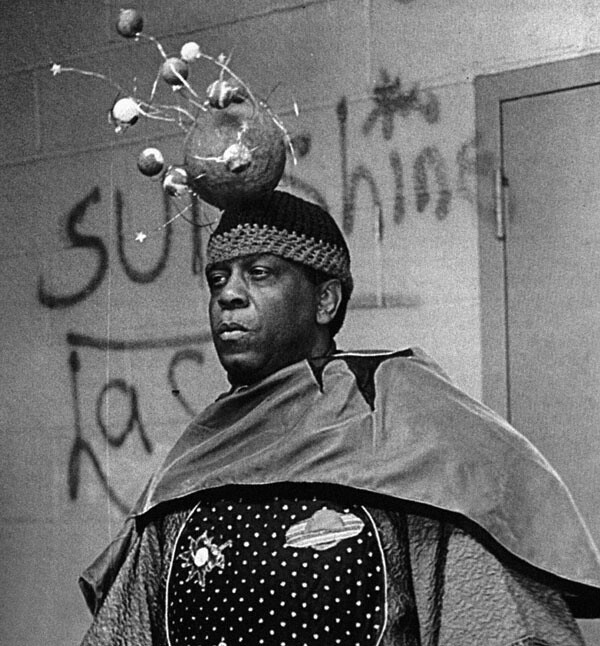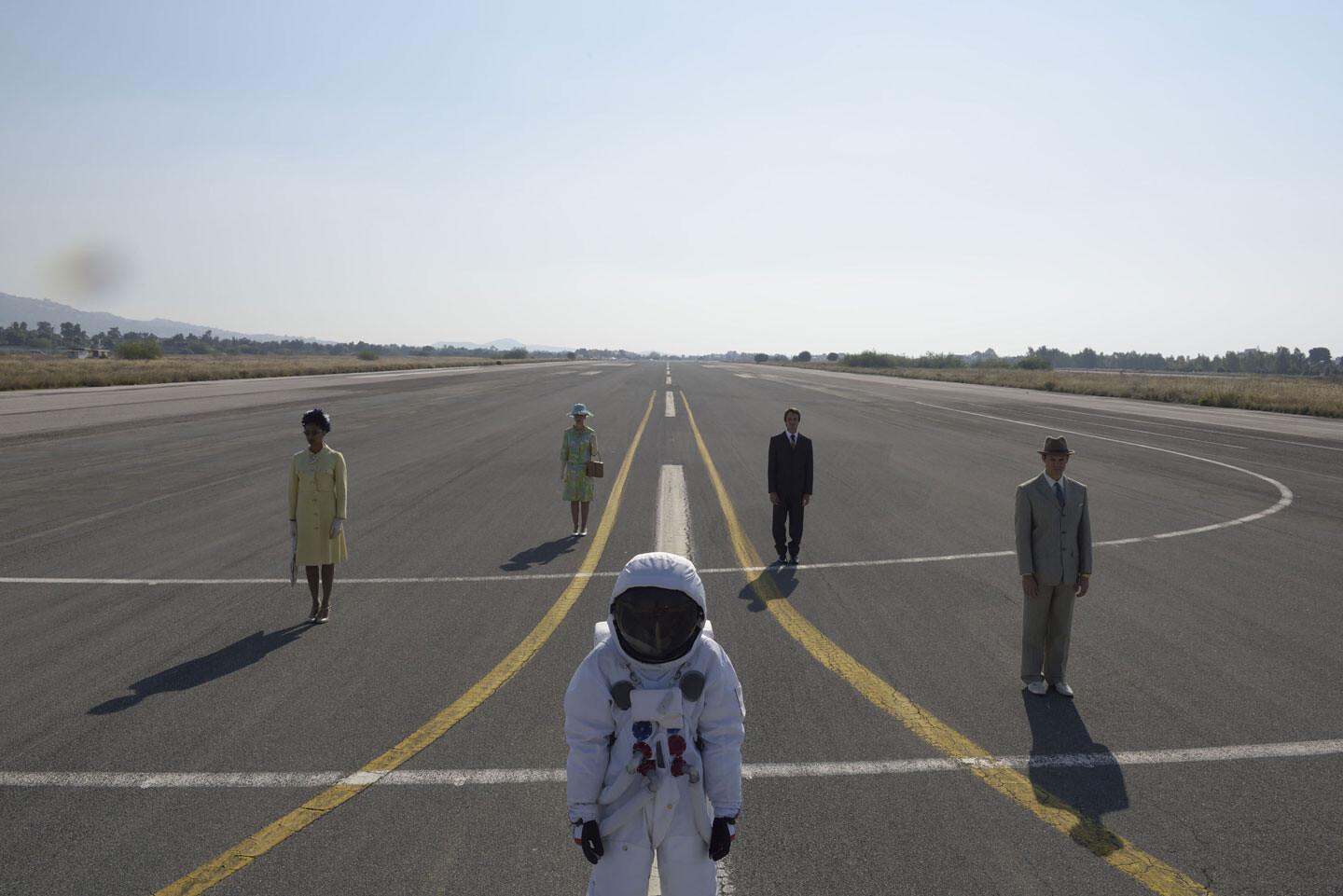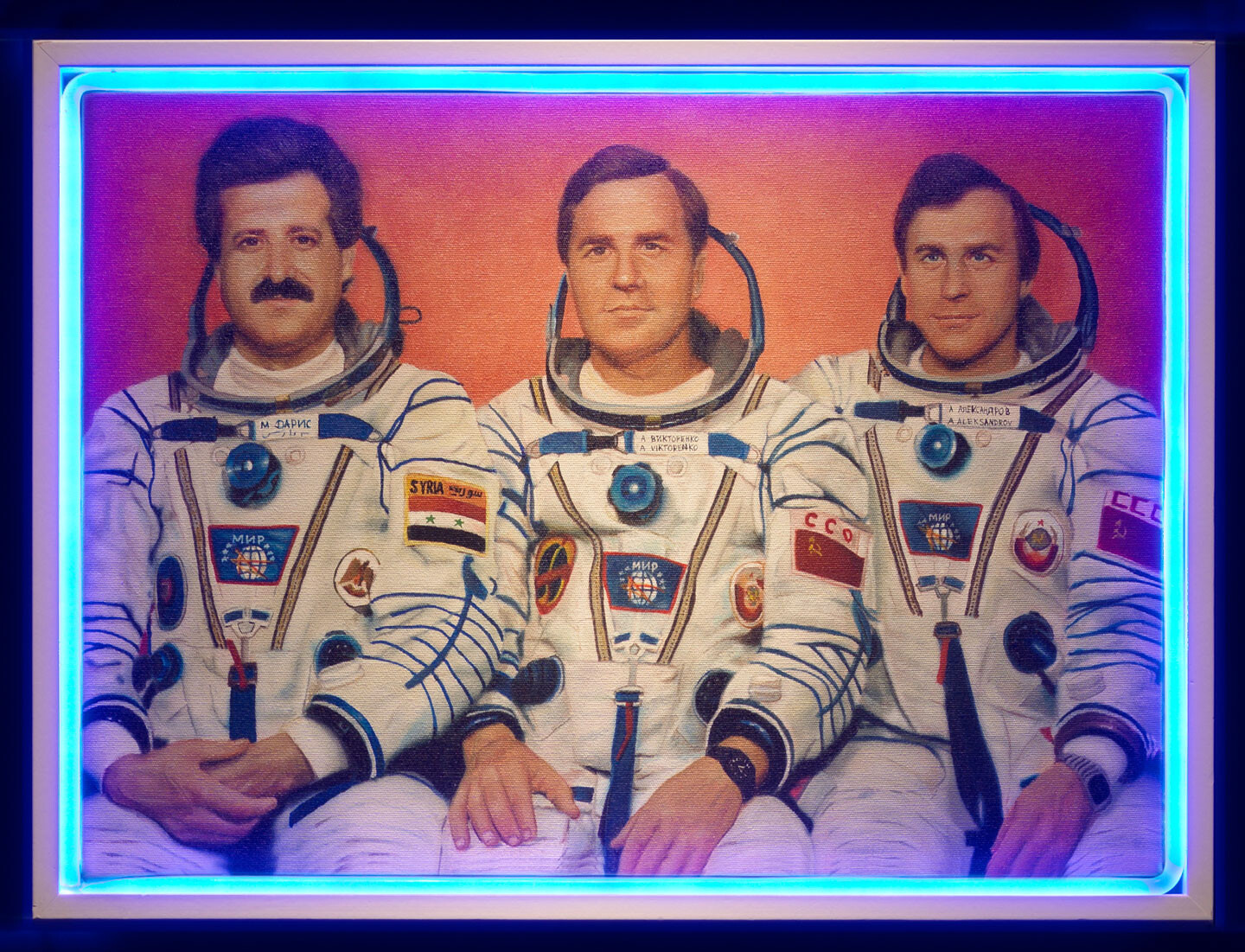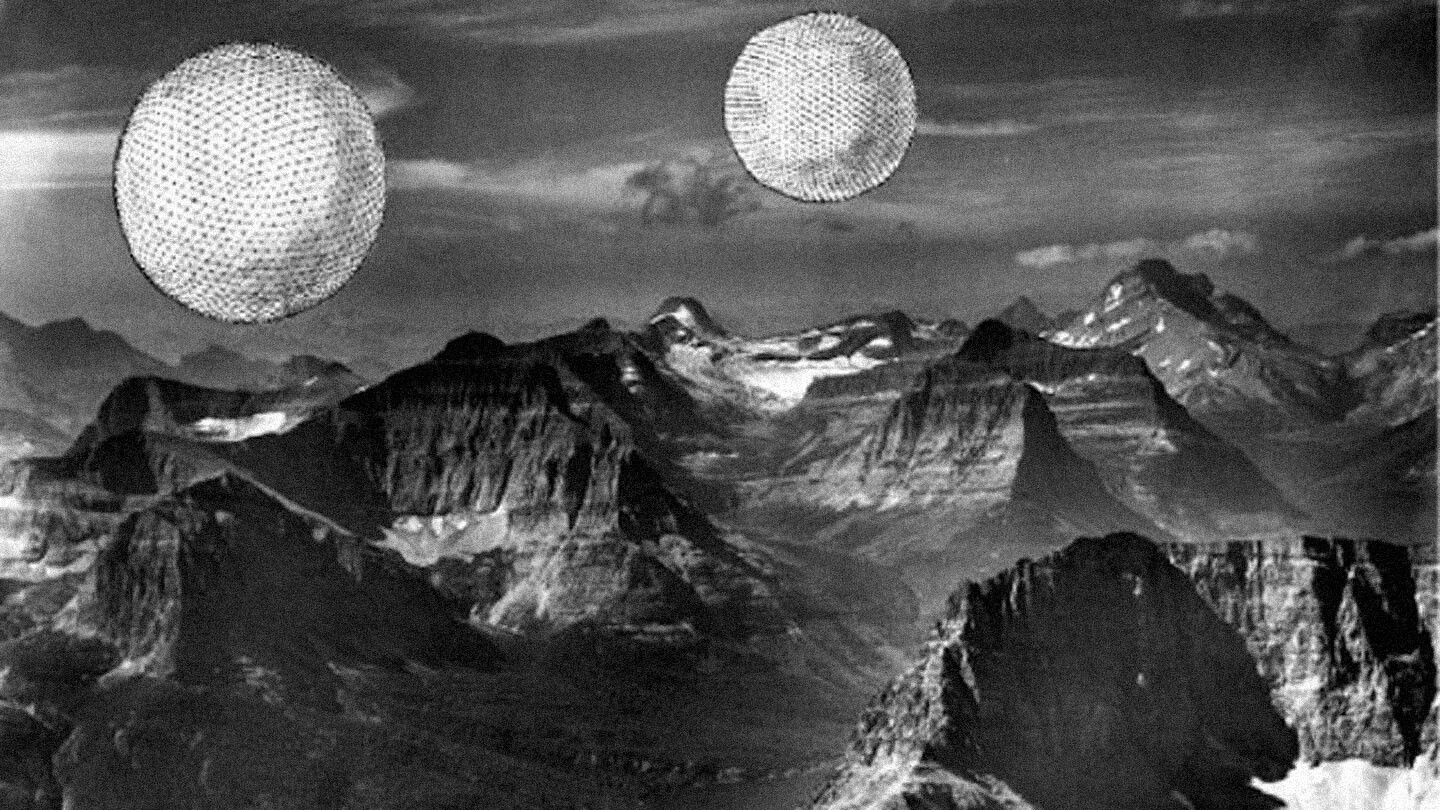You’re on the Spaceship Earth […]
You’d better pay your fare now
You’ll be left behind
You’ll be left hangin’
In the empty air
You won’t be here and you won’t be there.—Sun Ra, 19681
For some, contemporary art has become a kind of alt-science platform for research and development projects that offer alternatives to the corporate control and surveillance of outer space. Artists working on issues about access to space are at the front line of a critical investigation about the contours of the future, both in its material form and social organization. Many of these artists are challenging the current expansion of capitalist and colonial practices into outer space, particularly that of so-called “primitive” accumulation: the taking of land and resources for private use. They recognize that much of the tremendous capital amassed in the early 2000s e-commerce and tech boom is now being funneled into astronomically costly “New Space” projects such as SpaceX, a company funded by PayPal cofounder Elon Musk, and Blue Origin, the space enterprise of Amazon’s Jeff Bezos.2
In response, quite a few visual artists are exploring visions of “free” space, of outer space as a public commons and place of projective imagination. To contextualize and understand such work, this essay draws on R. Buckminster Fuller’s (1895–1983) concept of “Spaceship Earth” and his “We are all astronauts” rhetoric of engineered bodies and technologized nature.3 In recent German and US curatorial projects charting the influence of Fuller on the work of contemporary artists—including MARTa Herford’s “We Are All Astronauts: The Universe of Richard Buckminster Fuller as Reflected in Contemporary Art” (2011); Haus der Kulturen der Welt’s “The Whole Earth: California and the Disappearance of the Outside” (2013); and the Walker Art Center’s “Hippie Modernism: The Struggle for Utopia” (2015)—the manner in which Fuller’s techno-utopianism is a touchstone in present day art practice has been examined.4 Fuller hoped to reorient mundane life towards a greater awareness of Earth as embedded in the wider cosmos, yet the eccentricity of his metaphor of Spaceship Earth, which characterizes architecture as an advanced technological vehicle that can supplant natural ecologies in sustaining life, has had lasting effects in how the future is envisioned as human-authored and technologically dependent.


Cristina de Middel, The Afronauts, 2012. Digital C-print, 39 x 39 in. Courtesy the artist.
Countering Fuller’s optimism about humanity’s orientation to outer space, a post-Apollo-missions generation of artists, born in the late 1960s to the 1980s, reckons with its own belatedness to a conception of space exploration as an aim of public culture in the current era of New Space privatization. Many of the artists in my discussion, who include Paweł Althamer, Halil Altindere, Frances Bodomo, Cristina de Middel, Larissa Sansour, Tomás Saraceno, and Apichatpong Weerasethakul, engage in explicit criticisms of Fuller’s techno-futurity.5 They register an elegiac sense that the era of space exploration as a program of knowledge acquisition, interspecies communication, and even intergalactic colonization—in short, the epoch of cosmic optimism—has receded if not ended. They join slightly older artists born in the 1950s, such as John Akomfrah, who reconsider how the applications of technologies in near and outer space, once billed as progressive, are rife with negative effects such as resource depletion and privatization, racial domination, and economic inequality. Given the fact that environmental damage, which is already prompting climate migrations, is being used to justify future off-planet colonization, space travel and space architectures have become central preoccupations of artworks made in the last decade or so.6
As important as Fuller to artists today is the influence of musician and impresario Sun Ra (1914–93) and his influential space fascination in the 1960s and 1970s, a project that can be summed up as “We are all aliens.”7 Ra’s landmark afrofuturist works such as the 1972/74 film Space is the Place, and his albums and performances with his band the Arkestra, continue to be immensely popular, often-cited works in contemporary art, his experiments with modal polytonality and polyrhythmic beats looms large in contemporary culture.8 Space is the Place, scripted in part from lectures Sun Ra gave while teaching a course in 1971 at UC Berkeley titled “The Black Man in the Cosmos,” follows Ra’s attempts to recruit African-Americans to a distant planet he hopes to settle. The plot centers on the menace of white scientists eager to obtain Ra’s interplanetary travel technology. Journeying back in time to a strip club in Chicago where he played piano in the 1940s, Ra meets a black “Overseer,” a Cadillac-driving pimp played by Ray Johnson, who proposes a wager to offer black Americans “earthly delights” against Ra’s hopes for their “altered destiny” in space. Ra eventually wins the bet and he raptures much of the black population of Oakland, California to join his space colony on Saturn.
In promoting a separatist vision of African-American culture as anticapitalist and technologically savvy, Sun Ra turned the function of black music and culture, traditionally exploited as entertainment, into a conduit for black advancement beyond white domination. For Ra, outer space became a utopian outside to segregation and white supremacy, a parallel dimension in which to model a life beyond discriminatory histories of colonization and injustice on Earth.9


Sun Ra, ca. 1969. Photo: Thomas Hunter.
Just as access to technology is always fraught with power inequalities (when a Theremin refused to work, Ra joked, “Even machines can be racist. We got to be ready for the space age”), to Ra the many injustices committed against African-Americans by scientists, including unethical scientific studies on black bodies, also extended to dominant culture’s diminishment of black accomplishments in acts of historical whitewashing.10 Ra led others to question the claims of universality in exploratory space travel and to make links between the history of slavery, the scarce resources available to the oppressed, and hopes for interplanetary travel: “What we never had for so long, space, outer space. Or no space at all. Squeezes so tight. From the slave ship to the shack to the tenement. No space to really move. No space to really function. Sun Ra & Co. herald Space to Come, Freedom, to move, to live again as ourselves. Expansion.”11
Like Janus’s two faces, Fuller’s euphoria about technologies expanding human access to the universe is inextricably linked to Ra’s sense of whites having robbed others of a place on Earth, thereby necessitating the flight into outer space. One important proposal of neo-afrofuturist artworks is to temper the vision of the future as a frontier of exploration and technological progress with recognition that the loss of history for enslaved and subjugated peoples was the defining condition of previous colonial endeavors.
The Argentina-born, Berlin-based artist Tomás Saraceno invents DIY tools to actually physically access the stratosphere. Saraceno tests the capacity of individuals to lift off the Earth without the institutional apparatuses of once-dominant nation-based programs or the immense private wealth of tech oligarchs’ current space enterprises. Fuller was fascinated with space capsules and space colony architecture, and the geodesic dome became the ur-object of his vision of the Earth as a mobile, streamlined, spherical media-receptive cabin. Like Fuller, Saraceno believes that a synthesis of humble, ad hoc prototypes and grand visions can generate concrete data for future experimental models. His Cloud Cities project (2009–present) is named after Fuller and Shoji Sadao’s 1960 Cloud Nine, a speculative proposal for floating structures intended to rise above planetary surfaces. As part of Cloud Cities, Saraceno traveled to remote Salar de Uyuni in southwest Bolivia, the world’s largest salt flat, to conduct trials of his Space Elevator, essentially a camping tent tethered to a clear plastic hot-air balloon.12 Though it goes beyond Fuller’s proposal by actually taking flight, Saraceno’s Space Elevator is a decidedly low-tech DIY bricolage construction, intentionally conjectural in its hope to keep the imagination of outer space open as a projective space for all.13
Space Elevator is part of a project Saraceno initiated called the Aerocene Foundation, the aim of which is to construct airborne vehicles sustained by solar energy alone, to access “space without rockets … free from borders, free from fossil fuels.”14 Saraceno hopes these balloons will eventually be tethered together as floating cities, to “contest political, social, cultural, and military restrictions that are accepted today.”15 For him, the paradigm of the floating city transgresses nation-state borders that, especially in the case of Latin America, reinscribe the power dynamics of colonialism onto the bodies of undesirable migrants, and reinforce land ownership as the criteria of citizenship. Saraceno’s Space Elevator, though as implausible as Fuller and Sadao’s speculative Cloud Nine in its current prototype form, echoes the immense heuristic potential of Fuller’s project to fire curiosity about social and political forms beyond the geo-territorial norms of Earth-bound citizenship.


Tomás Saraceno, Space Elevator, 2009–10. Courtesy the artist.
The “space race” of the 1950s to the 1990s unabashedly employed the language of competition. But what of the individuals and nations that did not qualify for the race? Had they no purchase on the vision of the future promised to the winners? Whereas Saraceno’s Cloud Cities attempts to create institutions and infrastructures that bypass wealthy nations’ and now billionaires’ monopolies on space travel, two separate but related projects by Cristina de Middel and Frances Bodomo address earlier moments of DIY space exploration. De Middel and Bodomo use the same historical incident—the founding of the Zambia National Academy of Science, Space Research and Philosophy in 1960—as a starting point for their investigations of non-Western space programs and the aspirations to self-determination following decolonization.
Edward Festus Mukuka Nkoloso, a school teacher who joined the Zambian resistance against British colonial rule, started the academy intending to beat the space programs of the US and the Soviet Union by sending a Zambian cadet there first. Nkoloso named the twelve Zambian cadets he selected for the mission the “Afronauts,” from which both a 2014 film by Bodomo and a 2012 photographic series and book by de Middel borrow their titles. Eventually Nkoloso settled on a seventeen-year-old girl, Matha Mwambwa, and her two cats, as candidates for travel to the moon and Mars. He asked UNESCO for seven million Zambian pounds to prepare for a 1964 launch, and requested over a billion dollars from private foreign funders. He was unsuccessful on both counts. Without resources, he nonetheless improvised a launchpad and trained his Afronauts. Bodomo’s film recreates Nkoloso’s unsophisticated launch equipment and restages his decidedly low-tech training techniques, which involved rolling down a hill in an oil drum to simulate g-force, and swinging from a tire to simulate weightlessness. Alongside archival documents, de Middel’s square-format color photographs restage scenes of Nkoloso’s efforts and recreate the improvised costumes of the Afronauts, with actors donning motorcycle helmets paired with raffia collars, duct tape, vacuum tubing, and Kente cloth to present visually outlandish yet wholly impractical space costumes. De Middel’s work emphasizes the artfulness of Nkoloso’s endeavor, his appropriation of the visual codes of astronauts’ suits and helmets, and the sleek look of rockets, all of which stood in for the actual journey. One can think of Nkoloso’s project as a proleptic performance of sorts: creating elaborate props and putting on a play acts as a morale-building exercise towards a collective vision of outer space unencumbered by expensive, functional transportation technologies.
Nkoloso’s unrequited quest for funding for Zambia to participate in the space age underscores the unequal allocation of global resources that stymies universal access to outer space, a zone legally unpossessable by international treaty but in practice monopolized by elites. Just as one could call for “socialized technology” to redistribute the benefits of advances among global populations, one can contest the ways racial exclusivity figures in the escape plans of “New Space” private enterprises.16 The big funders of all New Space companies are white men.17 Given the lack of diversity of powerful figures then and now in science research, exploration, and entrepreneurship, it isn’t surprising that socialist, not capitalist, countries put the first woman (Valentina Tereshkova, Russia, 1963) and black man (Arnaldo Tamayo Méndez, Cuba, 1980) into space. In this sense the racial and gender dimensions of the Afronaut proposition are striking in that all the actors used by de Middel and Bodomo are black, as were the original Afronauts, creating a cast of space travelers akin to Sun Ra’s all-African-American Arkestra, one never seen in actual space voyages.


John Akomfrah, The Airport, 2015. Three-channel HD color video installation, 7.1 sound, 53 minutes. Copyright: Smoking Dogs Films. Courtesy of Lisson Gallery.
Ra deployed the image of an ancient Egyptian ark as the vehicle for reaching outer space; any vision of future travel relies on elements of material culture available today and in the past. In John Akomfrah’s fifty-three-minute, three-channel film installation The Airport (2016), the central character is a besuited and helmeted astronaut, who, at various moments, is seen through his helmet visor to be a black man. He wanders through an abandoned airport in Athens, comingling with waiting passengers in Edwardian garb as well as those in postwar 1950s fashions. The anachronism of these travelers, all stranded in the ruin of a transportation hub, suggests the instability caused by the exodus of capital during the Greek financial crisis that began in 2010, and also older histories of migration. Akomfrah argues that the airport is a site of both memory and futurity. The film, according to Akomfrah, explores “the sense that there’s a place that you can go where you’re free from the shackles of history. The airport can stand for that because it’s a kind of embodiment of national—maybe even personal—ambition. The space where flight, or dreams, or betterment, can happen.”18 Akomfrah’s astronaut moves not only between spaces but between eras—one of his sources for The Airport’s palimpsest of historical references was Stanley Kubrick’s 1968 film 2001: A Space Odyssey, whose concluding “stargate” sequence depicts the astronaut Bowman existing in various moments of the past and future simultaneously. Cultural theorist Tisa Bryant has stated of afrofuturism that it is “about space in the most literal of terms, just actual space, a continuum of boundary-less space where there is encounter and exchange across time.”19 Though these vectors across space and time often have to do with colonial legacies of slavery and the middle passage, afrofuturism is also a lens by which to refract unresolved contemporary struggles of domination and repression, and an argument for equally distributed resources.
Two works by Paweł Althamer—Astronaut 1 (1995), filmed in Bydgoszcz, Poland, and Astronaut 2 (1997), performed during Documenta X in Kassel, Germany—have also explored the estrangement from contemporaneous time and space that the figure of the astronaut represents. In Astronaut 1 the artist traversed the city of Bydgoszcz in a homemade space suit, recording the local scene with a video camera as though it were an extraterrestrial civilization. In the follow-up piece Astronaut 2, Althamer engaged an itinerant man, costumed as an astronaut, to live in a trailer on the grounds of the Orangerie Palace, one of the central venues for the Documenta exhibition. On view in the trailer was a reperformance of Astronaut 1 filmed in Kassel. Continuing to explore how socially ignored or undesirable humans are treated as aliens on Earth, in 2009 he invited one hundred sixty of his neighbors from Tower 13 of his housing block in Bródno, Warsaw to dress in metallic gold space suits and board a gilded 737 airplane. They traveled to Brasilia, Brussels, Bamako in Mali, and Oxford, England as though they were representatives of another planet. The project, titled Common Task, was partly a celebration of the twenty-year anniversary of the 1989 victory of Polish solidarity, and the “alien landing” in Belgium served as a reminder of the continuing outsider status of Poles in Europe, in spite of Poland’s 2004 inclusion into the European Union.20


Paweł Althamer, Common Task, 2009. Courtesy the artist and Modern Art Oxford.
Reminiscent of Althamer’s space-suited homeless person living in a mobile home as though it were a space capsule, Apichatpong Weerasethakul’s eight-channel film and sculptural installation Primitive (2009–11) also employs a roughshod spaceship, in his case to probe now-repressed political events in Southeast Asia. A follow-up to his 2006 film Faith, in which two Asian astronauts, each allotted his own channel of a two-screen projection, suffer the isolation of a blinding white spaceship, Primitive brought Weeresethakul’s interest in outer space to the improbable location of the small community of Nabua in remote northeastern Thailand. In 1965, Nabua was the site of the first confrontation between communist fighters and Thai Army forces that began a long and bloody insurgency, and the village suffered enormously during the brutal anti-communist mass killings in 1971–73 that left countless thousands dead and many tortured. Weerasethakul noted how the eradication of significant numbers of the population during these actions created a generation gap between teenagers and village elders, and he was struck by how the violence became shrouded in traumatic silence. He expresses doubt that recent discussions of species extinction have sufficiently accounted for the tremendous intra-human slaughter of recent wars and violent conflicts: to him, Primitive is in large part “about the elimination of many things, of species, of ideologies, of beliefs.”21
The films document life in Nabua from the perspective of the town’s young: their joyrides on pickup trucks and their game with a flaming soccer ball, for example. Two of the films portray the construction of a domed “spaceship” in the village that eventually lifts off the ground. “What better time to be able to leave Thailand?” Weerasethakul asks, pondering the driftlessness and confusion of the teens’ lives in a place that has tried to bury its past.22 The teens use the completed spaceship as a place to play music, drink, and get high, changing the interior into a blood-red crash pad. Elders in the village want to use the ship to store rice. Like Bodomo and de Middel’s work recovering the history of the Afronauts, Weerasethakul underscores the cultural meaning of the spaceship as more than a vehicle capable of transporting bodies across space, instead seeing it as a mnemonic architecture that sutures past to future, like an ark bridging traumatic histories to future hopes.
For nations like Thailand, Poland, and Zambia, lacking resources to participate in the space age compounds perceptions of technological “backwardness” already present in stereotypes of third-world nations as primitive or folkloric. Exploring the “frontier” in space exploration—a project pioneered largely by whites from wealthy nations with racist colonial histories—can easily be read as a form of domination that substitutes the distraction of “conquest” in the future for responsibilities to the “conquered” of the past. Artists are finding ways to address the uneven distribution of technological advancement by examining progress both geographically as well as temporally, returning to precolonial histories and readdressing legacies of colonial violence.23
In contrast, New Spacers like Musk and Bezos treat outer space, ostensibly free of indigenous peoples, as a new frontier exempt from the exploitation that characterized earlier colonial projects. And yet voluntary, touristic travel remains an experience of privilege; for many around the globe, travel is undertaken in forced and dangerous circumstances. Halil Altindere’s 2017 installation Space Refugee focuses on cosmonaut Muhammed Faris, who became the first Syrian to travel to space in 1987. The work is anchored by a curving wall-sized photo mural of Faris, replete with 1980s bushy mustache, performing a space walk outside the Mir space station, the scene embellished with colorful nebula and planets. Facing the mural is a small oil and acrylic portrait of Faris with two Russian cosmonauts, fully suited but for their helmets in their laps. The painting is framed by a blue neon-like LED light that lends the painting a garish, retro-futuristic look reminiscent of Ridley Scott’s 1982 movie Blade Runner. Shown alongside these works is the twenty-minute film Space Refugee (2016), elaborating Faris’s plight as a stateless exile and envisioning outer space as the ideal sanctuary for homeless and refugee populations.


Halil Altindere, Muhammed Ahmed Faris with Friends #1, 2016. Oil on canvas, LED, 40.5 x 54.4 x 6 cm framed. Courtesy of the artist and Andrew Kreps Gallery, New York, and Pilot Gallery, Istanbul.
A Russian-trained cosmonaut who traveled to the Mir space station in 1987, Faris spoke out against the Assad regime and joined the armed opposition in 2011. Eventually, he and his family fled Syria, illegally crossing into Turkey. In the film, Faris describes the discrimination against refugees he and others experience, and reveals his hope that “we can build cities for them there in space where there is freedom and dignity, and where there is no tyranny, no injustice.”
The film intercuts shots of astronauts—later revealed to be kids in child-sized space suits—walking amid rovers in rugged terrain, with talking-head interviews with NASA/JPL scientists, an aviation lawyer speaking about colonizing Mars, and an architect designing underground shelters for the harsh Martian climate. In a talk addressing a group of schoolchildren, Faris proclaims that “space belongs to whoever wants to learn and has power. Space does not belong to anyone. But whoever has the technology can go, and those who don’t, can’t.”
Three of the child-astronauts teleport into a red cave. One of the scientists explains that life on Mars will take place in shelters and underground, and the film pans across a colony of barracks complete with three geodesic domes silhouetted against a distant Earth. The architect speaks about how to build such habitations to avoid surface radiation, lauding 3-D printing as a means to construct entire buildings, and his digital renderings show the elegant, spacious interiors, verdant with greenery. Suddenly Mars has become a tidy but sterile corporate atrium.24 As the film ends Faris proclaims, “I will go with [the refugees] to Mars, to Mars, where we will find freedom and safety … there is no freedom on Earth, there is no dignity for humans on Earth.”
Larissa Sansour’s work A Space Exodus (2009) likewise portrays space travel as a means to process the nachträglichkeit, repression, and displacement of now stateless migrants in the Middle East. Sansour’s five-and-a-half minute film depicts the artist as an astronaut taking off in a shuttle and eventually landing on the Moon to plant a Palestinian flag on its surface. Seen in a white space suit with bulging visor, a close-up of her face shows her waving goodbye to the distant Earth. As she turns to hop away in the low-gravity environment, an Arabic-inflected version of the heroic Richard Strauss orchestral work “Also sprach Zarathustra,” famously used in Kubrick’s 2001: A Space Odyssey, plays. Evoking afrofuturists’ yearning to find in outer space freedom beyond histories of racial subjugation, Sansour’s outer space is also a haven, a place to establish a state for Palestinians who have been denied reparations for the loss of their land and resources.
Outer space, where so few have been, remains a preeminent projective space in the cultural imagination: the place wherein reside fantasies of rebirth, of reinvention, of escape from historical determinations of class, race, and gender inequality, and of aspirations for just societies beyond the protection of the Earth’s atmosphere. The imagination of space itself frequently exceeds any known spectatorial experience, and therefore envisoning it is a speculative political project in the sense that Frederic Jameson has written of science fiction:
The apparent realism, or representationality, of [science fiction] has concealed another, far more complex temporal structure: not to give us “images” of the future—whatever such images might mean for a reader who will necessarily predecease their “materialization”—but rather to defamiliarize and restructure our experience of our own present, and to do so in specific ways distinct from all other forms of defamiliarization.25
Rather than dismiss “imaging” the future as a form of literalization, however, it is important to consider how visual artists use images and material to effectuate the defamiliarization about which Jameson writes. We don’t often speak of visual art using the language of science fiction in this critical sense. Yet the visions of our future in space in the projects I have addressed are self-aware about how the problems of the present may blossom into the possible triumphs or catastrophes of tomorrow. Though scarce resources may be used in better ways than for moving bodies into space for tourism or colonization, space provides a speculative zone to imagine how to organize resources on Earth, including those used to fund scientific projects of exploratory character.
In considering how space exploration is treated in visual art, Fuller’s call to explore near and outer space using the rhetoric of “Spaceship Earth” has fascinating repercussions, both for visualizing the Earth as a technologized object as well as conceptualizing its “evolutionary” development as merely the first among several future human colonies in the universe. Reclaiming the civic and utopian project of space exploration in art, in the current era of privatization, tourism, and surveillance technologies, is one of the key stakes for those returning to Fuller’s vision. To this, Ra’s demand to diversify access to space and space fantasies opens up Jameson’s project of defamiliarization to the hope of a more equal tomorrow: “Hold it people, I see a flying saucer comin’, guess I wait and see. Yeah, a spaceship comin’, guess I wait and see. All I know they might look just like me.”26
Quoted in John F. Szwed, Space Is the Place: The Life and Times of Sun Ra (Pantheon Books, 1997), 261.
In a forthcoming essay titled “Art in the ‘New Space’ Age” I take up the privatization of space exploration, the hardship of capsule life, and artificial ecologies in the work of contemporary artists Matthew Day Jackson, MPA, Rachel Rose, Tom Sachs, Connie Samaras, Tavares Strachen, and Jane and Louise Wilson. My work on feminism, space ecologies, and climate change will soon appear in Texte zur Kunst as “Feminist Futures in the Anthropocene,” in which I consider works by Dawn DeDeaux, Sylvie Fleury, Aleksandra Mir, and Martine Syms. The relationship between satellite technologies, surveillance, and the corporate occupation of near space focusing on projects by Trevor Paglen and Hito Steyerl is the topic of another chapter of my book-in-progress, After Spaceship Earth, about the legacy of Buckminster Fuller in contemporary art.
Fuller coined the phrase “Spaceship Earth” in 1951, according to Claude Lichtenstein. See Your Private Sky: R. Buckminster Fuller, eds. Joachim Krausse and Claude Lichtenstein (Lars Muller Publishers, 2001), 279. Fuller foregrounded the concept in his book Operating Manual for Spaceship Earth (E. P. Dutton & Co., 1963). Further speculations about life in outer space were propagated by Fuller’s acolyte Stewart Brand, the founder of the Whole Earth Catalog and editor of the 1977 volume Space Colonies (Penguin Books, 1977). Brand is discussed in depth in my essay “Feminist Futures in the Anthropocene” (forthcoming in Texte zur Kunst).
These projects join my earlier effort, published in the fall of 2010, that explored Fuller’s influence in contemporary art: Eva Díaz, “Dome Culture in the Twenty-First Century,” in Grey Room 42 (Winter 2011), 80–105. We Are All Astronauts: The Universe of Richard Buckminster Fuller as Reflected in Contemporary Art, ed. Markus Richter (Kerber Verlag, 2012); The Whole Earth: California and the Disappearance of the Outside, eds. Diedrich Diederichsen and Anselm Franke (Haus der Kulteren der Welt and Sternberg Press, 2013); and Hippie Modernism: The Struggle for Utopia, ed. Andrew Blauvelt (Walker Art Center, 2015).
A longer version of this essay includes a discussion of works by Neil Beloufa and Daniel Ortega.
My project focuses on works that go beyond imaginatively depicting outer space or fantastical space journeys, and that see in outer space stakes further than futuristic style. Several recent exhibitions have tackled topics of space exploration and colonization, most notably Space Is the Place, a 2006–08 exhibition that traveled to multiple venues throughout the US (Alex Baker and Toby Kamps, curators and editors, Space is the Place, Independent Curators International and Cincinnati Contemporary Arts Center, 2007), and Space: About a Dream, a 2011 exhibition at Kunsthalle Wien (Cathérine Hug, curator and editor, Space: About a Dream, Verlag für Moderne Kunst Nürnberg, 2011). These shows placed a not-insignificant emphasis on artworks representing the starry heavens as a kind of transcendent site of sublime but inhospitable beauty and vastness.
Sun Ra proclaimed himself an alien from Saturn. He also used the phrase “Spaceship Earth,” often coupled with a near mystical sense that leaving the Earth would inaugurate humanity’s spiritual redemption. See Szwed, Space Is the Place, 261. For recent scholarship on Ra and afrofuturism, see Paul Youngquist, A Pure Solar World: Sun Ra and the Birth of afrofuturism (University of Texas Press, 2016). For more about the legacy of afrofuturism in contemporary art, see The Shadows Took Shape, eds. Naima J. Keith and Zoe Whitley (Studio Museum in Harlem, 2013). For a consideration of the fascination with futurity and space travel from a Latin American perspective, see the catalog for the Bowdoin College Museum of Art show of the same name: Past Futures: Science Fiction, Space Travel, and Postwar Art of the Americas, ed. Sarah J. Montross (MIT Press, 2015). Though more focused on afrofuturist literature, the issue of the journal Social Text (no. 71, June 2002) dedicated to the topic is of interest.
The term “afrofuturism” was coined in 1993 by cultural critic Mark Dery in his interviews with Samuel R. Delany, Greg Tate, and Tricia Rose titled “Black to the Future,” in Flame Wars: Discourses of Cyberculture, ed. Dery (Duke University Press, 1994).
That this flight to outer space for Ra often involved apocalyptic musings about the end of life on Earth as punishment for the vicious treatment of Africans by Europeans is part of the trajectory of forms of radical black millenarianism that Aria Dean has termed “blacceleration.” See her “Notes on Blacceleration,” e-flux journal 87 (December 2017) →. Ra’s proposal differs greatly from the vision of outer space promoted by white rock groups in the 1960s and 1970s, which emphasized, as Diedrich Diederichsen has written, a “structural connection between the trip to outer space and the journey inward to the self … in which outer and inner cosmos comingled.” The new vantage provided of the Earth from outer space was revolutionary in this connection between identity and cosmos. Diederichsen, “Pop Music and the Counterculture: The Whole World and Now,” in The Whole Earth, eds. Diederichsen and Anselm Franke, 20–31, quote is on pages 22 and 24. See also Päivi Väätänen, “Sun Ra: Myth, Science, and Science Fiction,” Fafnir – Nordic Journal of Science Fiction and Fantasy Research 1, no. 4 (2014): 39–46.
A large part of Ra’s cosmic mythology draws on his views about the technological and philosophical advancement of ancient black Egyptian Hamitic culture, which predated Judeo-Christian ideologies of white supremacy that claimed Hamitics as a Caucasian tribe. To Ra, understanding the glory of the African past could allow blacks to reclaim their heroic blackness and build a future in outer space. Quote is Ra in 1969, Szwed, Space Is the Place, 276.
Joe Gonçalves, “Sun Ra at the End of the World,” The Cricket, no. 4 (1969): 9–11, quoted in Szwed, Space Is the Place, 140. Gonçalves was reviewing the Arkestra’s first West Coast appearance in 1969.
Saraceno chose the Salar de Uyuni as the site for the project in part because of the reflective qualities of the lake bed, which after rainfall becomes covered with a thin layer of water that creates the illusion of a limitless landscape of clouds.
The concept of a space elevator is credited to Russian rocket scientist Konstantin Tsiolkovsky, who in 1895 published a design for a compression-based tower that would reach a height of geostationary orbit. Fuller, in a conversation with sci-fi writer Arthur C. Clarke, claimed that in 1951 he came up with an idea for a tensile structure that would act as a “ring-bridge” to be accessed by a future space elevator. See Fuller’s sleeve notes for Clarke’s audio book The Fountain of Paradise (1979) recording (Caedmon TC 1606).
From aerocene.org →.
Sueli Ferreira Lima Fortin in conversation with Saraceno, published August 6, 2012 in CO2* Art and Sustainability →.
For a discussion of a socialism of technology, see pages 45–46 in Liu Cixin, The Dark Forest (Tor Books, 2016), originally published in China in 2008.
David Valentine, “Exit Strategy: Profit, Cosmology, and the Future of Humans in Space,” Anthropological Quarterly 85, no. 4 (Fall 2012): 1066 fn. 6. See also my essay “Art in the ‘New Space’ Age.”
Akomfrah, in Tess Thackara, “John Akomfrah Summons the History of Migration in Chillingly Beautiful New Films,” Artsy, June 23, 2016 →.
Bryant, video interview in KCET and Martin Syms, “Artbound Episode: The Mundane Afrofuturist Manifesto,” November 18, 2015 →.
“Alien landing” is the phrase employed to describe the project by the Polish Institute of the Cultural Service of the Polish Embassy in Belgium, which helped sponsor Althamer’s project.
Excerpts from video interview with Weerasethakul at Haus der Kunst, Munich, 2009 →.
Aily Nash, “We Are Primitive: Apichatpong’s Ineffable Experience of Nabua,” The Brooklyn Rail, July 11, 2011 →.
What artist Robert Smithson called “Where remote futures meet remote pasts” in his essay “A Sedimentation of the Mind: Earth Projects,” (1968), discussed in Sarah J. Montross, “Cosmic Orbits: Observing Postwar Art of the Americas from Outer Space,” in Past Futures: Science Fiction, Space Travel, and Postwar Art of the Americas, ed. Montross (MIT Press, 2015), 14–47.
A work such as Erik Sanner’s Mars Tea Room (2016–17), in which a modest mobile geodesic structure is offered for drinking tea crops to be grown on Mars, may serve as a counterpoint to the slick visions of Mars presented by the interview subjects in Altindere’s film. Felicity D. Scott provides a brief genealogy connecting “controlled interior spaces” like greenhouses and corporate atria, see Scott, “Earthlike,” Grey Room 65 (Fall 2016): 17.
Fredric Jameson, “Progress Versus Utopia: or, Can We Imagine the Future?” Science Fiction Studies 9, no. 2 (July 1982): 151.
Henry Dumas, “Outer Space Blues,” poem dedicated to Sun Ra, c. 1965–68. Henry, or Hank, Dumas, wrote the liner notes to Sun Ra’s 1967 album Cosmic Tones, and was a close associate of Ra’s, especially between 1965–66. Henry Dumas, “Outer Space Blues,” in Knees of a Natural Man: The Selected Poetry of Henry Dumas, ed. Eugene B. Redmond (Thunder’s Mouth Press, 1989), 66–67. Dumas was shot dead in 1968 by a New York City Transit policeman. According to John Szwed, “When Sun Ra heard about it, he became angrier than anyone had ever seen him before, and he raged on and on for days.” Szwed, Space Is the Place, 223.

